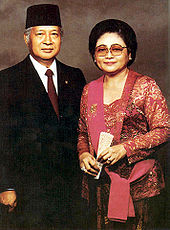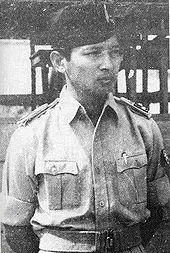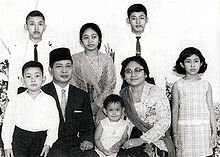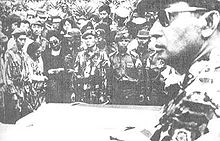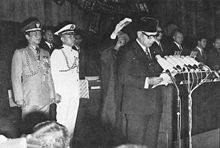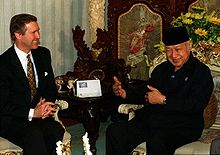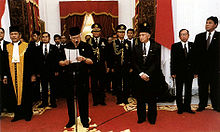- Suharto
-
Suharto 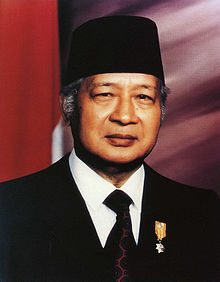
2nd President of Indonesia In office
27 March 1968 – 21 May 1998Vice President Hamengkubuwono IX
Adam Malik
Umar Wirahadikusumah
Sudharmono
Try Sutrisno
Bacharuddin Jusuf HabibiePreceded by Sukarno Succeeded by Bacharuddin Jusuf Habibie 16th Secretary General of Non-Aligned Movement In office
7 September 1992 – 20 October 1995Preceded by Dobrica Ćosić Succeeded by Ernesto Samper Pizano 4th Indonesian Armed Forces Commander In office
1969–1973Preceded by Abdul Haris Nasution Succeeded by Maraden Panggabean 8th Indonesian Army Chief of Staff In office
1965–1967Preceded by Pranoto Reksosamudra Succeeded by Maraden Panggabean 1st Armed Force and Strategic Reserve (KOSTRAD) Commander In office
1961–1965Preceded by Position created Succeeded by Umar Wirahadikusumah Personal details Born 8 June 1921
Kemusuk, Dutch East IndiesDied 27 January 2008 (aged 86)
Jakarta, IndonesiaNationality Indonesian Political party Golkar Spouse(s) Siti Hartinah (d. 1996) Children Siti Hardiyanti Hastuti[1]
Sigit Harjojudanto
Bambang Trihatmodjo
Siti Hediyati Hariyadi
Hutomo Mandala Putra
Siti Hutami Endang AdiningsihProfession Military Religion Islam[2] Signature 
 Suharto (help·info) (8 June 1921 – 27 January 2008) was the second President of Indonesia, having held the office for 32 years from 1967 following Sukarno's removal until his resignation in 1998.
Suharto (help·info) (8 June 1921 – 27 January 2008) was the second President of Indonesia, having held the office for 32 years from 1967 following Sukarno's removal until his resignation in 1998.Suharto was born in a small village, Kemusuk, in the Godean area near Yogyakarta, during the Dutch colonial era.[3] He grew up in humble circumstances.[4] His Javanese peasant parents divorced not long after his birth, and he was passed between foster parents for much of his childhood. During the Japanese occupation of Indonesia, Suharto served in Japanese-organised Indonesian security forces. Indonesia's independence struggle saw him joining the newly formed Indonesian army. Suharto rose to the rank of Major General following Indonesian independence. An attempted coup on 30 September 1965 was countered by Suharto-led troops and was blamed on the Indonesian Communist Party.[5] The army subsequently led an anti-communist purge, and Suharto wrested power from Indonesia's founding president, Sukarno. He was appointed acting president in 1967 and President the following year. Support for Suharto's presidency was strong throughout the 1970s and 1980s but eroded following a severe financial crisis that led to widespread unrest and his resignation in May 1998. Suharto died in 2008.
The legacy of Suharto's 32-year rule is debated both in Indonesia and abroad. Under his "New Order" administration, Suharto constructed a strong, centralised and military-dominated government. An ability to maintain stability over a sprawling and diverse Indonesia and an avowedly anti-Communist stance won him the economic and diplomatic support of the West during the Cold War. For most of his presidency, Indonesia experienced significant economic growth and industrialisation,[6] dramatically improving health, education and living standards.[7] Indonesia's invasion and occupation of East Timor during Suharto's presidency, which received de facto support from the United States, United Kingdom and Australia at the time, resulted in at least 100,000 deaths.[8] By the 1990s, the New Order's authoritarianism and widespread corruption[9] were a source of discontent.[10] In the years after his presidency, attempts to try him on charges of corruption and genocide failed because of his poor health and because of lack of support within Indonesia.
Contents
Early life
Suharto was born on 8 June 1921 during the Dutch East Indies era, in a plaited bamboo walled house in the hamlet of Kemusuk, a part of the larger village of Godean. The village is 15 kilometres (9.3 mi) west of Yogyakarta, the cultural heartland of the Javanese.[7] Born to ethnic Javanese parents of peasant class, he was the only child of his father's second marriage. His father, Kertosudiro had two children from his previous marriage, and was a village irrigation official. His mother Sukirah, a local woman, was distantly related to Sultan Hamengkubuwono V by his first concubine.[11]
Five weeks after Suharto's birth, his mother suffered a nervous breakdown and he was placed in the care of his paternal great-aunt, Kromodiryo.[12] Kertosudiro and Sukirah divorced early in Suharto's life and both later remarried. At the age of three, Suharto was returned to his mother who had remarried a local farmer whom Suharto helped in the rice paddies.[12] In 1929, Suharto's father took him to live with his sister who was married to an agricultural supervisor, Prawirowihardjo, in the town of Wurjantoro in a poor and low-yield farming area near Wonogiri. Over the following two years, he was taken back to his mother in Kemusuk by his stepfather and then back again to Wurjantoro by his father.[13]
Prawirowiharjo took to raising the boy as his own, which provided Suharto a father-figure and a stable home in Wuryantoro, from where he received much of his primary education. Suharto boarded with a dukun ("guru") of Javanese mystical arts and faith healing. The experience deeply affected him and later, as president, Suharto surrounded himself with powerful symbolic language.[7] During this time, the Wonogiri area was one of the worst affected in Java from the collapse in the Dutch East Indies' export revenue during the Great Depression. As unemployed workers returned from the towns to their villages, the subsistence economy grew and the landless struggled to buy food.[13]
The absence of official documentation and certain aspects of Suharto's early life that are inconsistent with that of a Javanese peasant (Suharto received, for example, an education fairly early on), has led to several rumours of Suharto being the illegitimate child of a well-off benefactor, which included being the child of a Yogyakarta aristocrat or a well-off Chinese Indonesian merchant.[14] Suharto biographer Robert E. Elson believes that such rumours cannot be entirely ruled out, given that much of the information Suharto has given on his origins has been tinged with political meaning.[14]
Like many Javanese, Suharto had only one name.[15] In religious contexts in recent years has sometimes been called “Haji” or “el-Haj Mohammed Suharto” but these names were not part of his formal name or generally used. The spelling "Suharto" reflects modern Indonesian spelling although the general approach in Indonesia is to rely on the spelling preferred by the person concerned. At the time of his birth, the standard transcription was "Soeharto" and he preferred the original spelling. The international English-language press generally uses the spelling 'Suharto' while the Indonesian government and media use 'Soeharto'.[16]
Suharto's upbringing contrasts with that of leading Indonesian nationalists such as Sukarno in that he is believed to have had little interest in anti-colonialism, or political concerns beyond his immediate surroundings. Unlike Sukarno and his circle, Suharto did not learn to speak Dutch or other European languages in his youth. He learned to speak Dutch after his induction into the Dutch military in 1940.[17]
Military career
World War II and Japanese occupation
See also: Japanese occupation of IndonesiaAfter finishing middle school at the age of 18, Suharto took a clerical job at a bank in Wurjantaro but was forced to resign after a bicycle mishap tore his only working clothes.[18] Following a spell of unemployment, he joined the Royal Netherlands East Indies Army (KNIL) in 1940, and studied in a Dutch-run military school in Gombong near Yogyakarta. With the Netherlands under German occupation and the Japanese pressing for access to Indonesian oil supplies, the Dutch had opened up the KNIL to large intakes of previously excluded Javanese.[19] After graduation, Suharto was assigned to Battalion XIII at Rampal. His service there was unremarkable, although he contracted malaria which required hospitalisation while on guard duty, and then gained promotion to sergeant.[20]
The March 1942 invasion of Imperial Japanese forces was initially welcomed by many Indonesians as a key step towards independence and Suharto was one of thousands of Indonesians who volunteered for Japanese organised security forces.[19] He first joined the Japanese sponsored police force at the rank of keibuho (assistant inspector), where he claimed to have gained his first experience in the intelligence work so central to his presidency[citation needed] ("Criminal matters became a secondary problem," Suharto remarked, "what was most important were matters of a political kind").[21]
Suharto shifted from police work toward the Japanese-sponsored militia, the Peta (Defenders of the Fatherland) in which Indonesians served as officers. In his training to serve at the rank of shodancho (platoon commander) he encountered a localized version of the Japanese bushido, or "way of the warrior", used to indoctrinate troops. This training encouraged an anti-Dutch and pro-nationalist thought, although toward the aims of the Imperial Japanese militarists. The encounter with a nationalistic and militarist ideology is believed to have profoundly influenced Suharto's own way of thinking.[22] The Japanese turned ex-NCOs, including Suharto, into officers and gave them further military education, including lessons in the use of the samurai sword. Suharto's biographer, O.G. Roeder, records in The Smiling General (1969) that Suharto was "well known for his tough, but not brutal, methods".
Indonesian National Revolution
See also: Indonesian National RevolutionTwo days after the Japanese surrender in the Pacific, independence leaders Sukarno and Hatta declared Indonesian independence, and were appointed President and Vice-President respectively of the new Republic. Suharto disbanded his regiment in accordance with orders from the Japanese command and returned to Yogyakarta.[23] As republican groups rose to assert Indonesian independence, Suharto joined a new unit of the newly formed Indonesian army. On the basis of his PETA experience, he was appointed deputy commander, and subsequently a battalion commander when the republican forces were formally organised in October 1945.[23] Suharto was involved in fighting against Allied troops around Magelang and Semarang, and was subsequently appointed head of a brigade as lieutenant-colonel, having earned respect as a field commander.[24] In the early years of the War, he organised local armed forces into Battalion X of Regiment I; Suharto was promoted to the rank of Major and became Battalion X's leader.[25]
The arrival of the Allies, under a mandate to return the situation to the status quo ante bellum, quickly led to clashes between Indonesian republicans and Allied forces, namely returning Dutch and assisting British forces. Suharto led his Division X troops to halt an advance by the Dutch T ("Tiger") Brigade on 17 May 1946. It earned him the respect of his superior, Lieutenant Colonel Sunarto Kusumodirjo, who invited him to draft the working guidelines for the Battle Leadership Headquarters (MPP), a body created to organise and unify the command structure of the Indonesian Nationalist forces.[26] The military forces of the still infant Republic of Indonesia were constantly restructuring. By August 1946, Suharto was head of the 22nd Regiment of Division III (the "Diponegoro Division") stationed in Yogyakarta. In late 1946, the Diponegoro Division assumed responsibility for defence of the west and southwest of Yogyakarta from Dutch forces. Conditions at the time are reported in Dutch sources as miserable; Suharto himself is reported as assisting smuggling syndicates in the transport of opium through the territory he controlled, to make income.[27]
In December 1948, the Dutch launched "Operation Crow", which decimated much of the Indonesian fighting forces, and resulted in the capture of Sukarno and Hatta.For his part, Suharto took severe casualties in a humiliating defeat for Republican forces as the Dutch invaded the area of Yogyakarta.[27] In dawn raids on 1 March 1949, Suharto's forces and local militia re-captured the city, holding it until noon.[28] Suharto's later accounts had him as the lone plotter, although other sources say Sultan Hamengkubuwono IX of Yogyakarta, and the Panglima of the Third Division ordered the attack. However, General Nasution said that Suharto took great care in preparing the "General Offensive" (Indonesian Serangan Umum). Civilians sympathetic to the Republican cause within the city had been galvanised by the show of force which proved that the Dutch had failed to win the guerrilla war. Internationally, the United Nations Security Council pressured the Dutch to cease the military offensive and to re-commence negotiations. Suharto reportedly took an active interest in the peace agreements, but as for many Republican military men, they were much to his dissatisfaction.[29]
During the Revolution, Suharto married Siti Hartinah (known as Madam Tien), the daughter of a minor noble in the Mangkunegaran royal house of Solo. The arranged marriage was enduring and supportive, lasting until Tien's death in 1996.[7] The couple had six children: Siti Hardiyanti Rukmana (Tutut, born 1949), Sigit Harjojudanto (born 1951), Bambang Trihatmodjo (born 1953), Siti Hediati (Titiek, born 1959), Hutomo Mandala Putra (Tommy, born 1962), and Siti Hutami Endang Adiningish (Mamiek, born 1964). Within the Javanese upper class, it was considered acceptable if the wife pursued genteel commerce to supplement the family budget, allowing her husband to keep his dignity in his official role. The commercial dealings of Tien, her children and grandchildren became extensive and ultimately undermined Suharto's presidency.[7]
Post-Independence military career
In the years following Indonesian independence, Suharto served in the Indonesian National Army, primarily in Java. In 1950, Colonel Suharto led the Garuda Brigade in suppressing a rebellion of largely Ambonese colonial-trained supporters of the Dutch-established State of East Indonesia and its federal entity the United States of Indonesia.[30] During his year in Makassar, Suharto became acquainted with his neighbours the Habibie family, whose eldest son BJ Habibie would later became Suharto's vice-president and went on to succeed him as President. In 1951, Suharto led his troops in a blocking campaign against the Islamic-inspired rebellion of Battalion 426 in Central Java before it was broken by the 'Banteng (Wild Buffalo) Raiders' led by Ahmad Yani.[31]
Between 1954 and 1959, he served in the important position of commander of Diponegoro Division, responsible for Central Java and Yogyakarta provinces. His relationship with prominent businessmen Liem Sioe Liong and Bob Hasan, which extend throughout his presidency, began in Central Java where he was involved in series of "profit generating" enterprises conducted primarily to keep the poorly funded military unit functioning.[32] Army anti-corruption investigations implicated Suharto in a 1959 smuggling scandal. Relieved of his position, he was transferred to the army's Staff and Command School (Seskoad) in the city of Bandung.[33] While in Bandung, he was promoted to brigadier-general, and in late 1960, promoted to chief of army intelligence.[7] In 1961, he was given an additional command, as head of the army's new Strategic Reserve (later KOSTRAD), a ready-reaction air-mobile force.[7]
In January 1962, Suharto was promoted to the rank of major General and appointed to lead Operation Mandala, a joint army-navy-air force command. This formed the military side of the campaign to win western New Guinea, from the Dutch who were preparing it for its own independence, separate from Indonesia.[7] In 1965, Suharto was assigned operational command of Sukarno's Konfrontasi, against the newly formed Malaysia. Fearful that Konfrontasi would leave Java thinly covered by the army, and hand control to the 2-million strong Indonesian Communist Party (PKI), he authorised a Kostrad intelligence officer, Ali Murtopo, to open contacts with the British and Malaysians.[7]
Overthrow of Sukarno (1965)
Main article: Transition to the New OrderBackground
See also: Guided Democracy in IndonesiaFrom the late 1950s, political conflict grew and the economy deteriorated. By the mid-1960s, annual inflation ran between 500–1,000%, export revenues were shrinking, infrastructure crumbling, and severe poverty and hunger were widespread. President Sukarno led his country in a military confrontation with Malaysia while stepping up revolutionary and anti-western rhetoric.[34][35] Sukarno's position came to depend on balancing the increasingly hostile forces of the army and Communist Party of Indonesia (PKI). By 1965 at the height of the Cold War, the PKI penetrated all levels of government. With the support of Sukarno, the party gained increasing influence at the expense of the army, thus ensuring the army's enmity.[36] By late 1965, the army was divided between a left-wing faction allied with the PKI, and a right-wing faction that was being courted by the United States.[37]
Abortive coup and anti-communist purge
Main articles: 30 September Movement and Indonesian killings of 1965–1966On the night of 30 September 1965 six senior army generals were kidnapped and executed in Jakarta by a battalion of soldiers from the Presidential Guard.[38] Backed by elements of the armed forces, the insurgents occupied Merdeka Square including the areas in front of the Presidential Palace, the national radio station, and telecommunications centre. At 7:10 a.m. Lt. Col. Untung Syamsuri announced on radio that the "30 September Movement" had forestalled a coup by "power-mad generals", and that it was "an internal army affair". Apart from Armed Forces Chief of Staff, General Abdul Haris Nasution—who was targeted but escaped assassination by climbing over his garden wall when soldiers arrived to arrest him—Suharto was the most senior general not removed by the 30 September group.[39] Suharto had been in hospital that evening with his three-year old son Tommy who had a scalding injury. It was here that he spoke to Colonel Abdul Latief, the only key person in the ensuing events with whom he spoke that evening.[40]
Upon being told of the shootings and disappearances, Suharto went to Kostrad headquarters just before dawn from where he could see soldiers occupying Merdeka Square. He led Kostrad in seizing control of the centre of Jakarta, capturing key strategic sites. Suharto announced over the radio at 9:00 p.m. that six generals had been kidnapped by "counter-revolutionaries". He said he was in control of the army, and that he would crush the 30 September Movement and safeguard Sukarno.[41] Suharto issued an ultimatum to Halim Air Force Base, where the G30S had based themselves and where Sukarno (the reasons for his presence are unclear and were subject of claim and counter-claim), General Omar Dhani and Aidit had gathered. The coup leaders fled Jakarta[42] while G30S-sympathetic battalions in Central Java quickly came under Suharto control.[43]
The poorly organised and coordinated coup thus failed,[44] and by 2 October, Suharto's faction was firmly in control of the army. Sukarno's obedience to Suharto's 1 October ultimatum to leave Halim changed all power relationships.[43] Sukarno's fragile balance of power between the military, political Islam, communists, and nationalists that underlay his "Guided Democracy" was collapsing.[44] Complicated and partisan theories continue to this day over the identity of the attempted coup's organisers and their aims. The army's (and subsequently the "New Order's") official version was that the PKI was solely responsible. Other theories include Suharto being behind the events; that the army and Suharto was merely taking advantage of a poorly executed coup; and that Sukarno was behind the events (see 30 September Movement).
A military propaganda campaign convinced both Indonesian and international audiences that it was a Communist coup, and that the murders were cowardly atrocities against Indonesian heroes.[45] The army led a campaign to purge Indonesian society, government and armed forces of the communist party and leftist organisations.[45] The purge quickly spread from Jakarta to the rest of the country.[46] (see: Indonesian killings of 1965–1966) In some areas the army organised civilian and religious groups and local militias, in other areas communal vigilante action preceded the army.[47] The most widely accepted estimates are that at least half a million were killed.[48][49][50][51] As many as 1.5 million were imprisoned at one stage or another.[52] As a result of the purge, one of Sukarno's three pillars of support, the Indonesian Communist Party, was effectively eliminated by the other two, the military and political Islam.
Power struggle
See also: SupersemarOn 2 October, Suharto accepted Sukarno's order to take control of the army on Suharto's condition that he personally have authority to restore order and security. The 1 November formation of Kopkamtib (Komando Operasi Pemulihan Keamanan dan Ketertiban, or Operational Command for the Restoration of Security and Order), formalised this authority.[53] By January 1966 the PKI, President Sukarno's strongest pillar of support, had been effectively eliminated, the army now saw its opportunity to occupy the apex of Indonesian power.[54] Sukarno was still the Supreme Commander by virtue of the constitution, thus Suharto was careful not to be seen to be seizing power in his own coup. For eighteen months following the quashing of the 30 September Movement, there was a complicated process of political manoeuvers against Sukarno, including student agitation, stacking of parliament, media propaganda and military threats.[55]
On 1 February 1966, Sukarno promoted Suharto to the rank of Lieutenant General. The same month, Gen. Nasution had been forced out of his position of Defence Minister,[56] and the power contest had been reduced to Suharto and Sukarno. The Supersemar decree of 11 March 1966 transferred much of Sukarno's power over the parliament and army to Suharto,[55] ostensibly allowing Suharto to do whatever was needed to restore order. On 12 March 1967, Sukarno was stripped of his remaining power by Indonesia's provisional Parliament, and Suharto was named Acting President.[57] Sukarno was placed under house arrest; little more was heard from him, and he died in June 1970.[58] On 27 March 1968, the Provisional Peoples Representative Assembly formally appointed Suharto for the first of his five-year terms as President.[59]
The "New Order" (1967–1998)
See also: New Order (Indonesia)Institutionalisation of the New Order
See also: Acting Presidency of SuhartoAt first, many saw Suharto as a comparatively obscure officer who had been fortuitously thrust to prominence by the events of late 1965 and assumed he would not remain in power long. However, by the early 1970s, he had consolidated his position by both isolating his rivals within the army and ruling elite and rewarding those loyal to him with patronage building the presidency into the most powerful institution in Indonesia. By the 1980s, Suharto dominated the New Order and his military contemporaries had retired or were otherwise no longer a threat to his position.[60]
In contrast to the communal and political conflicts, economic collapse and social breakdown of the late-1950s and mid-1960s, Suharto's "New Order" —so-termed to distinguish it from Sukarno's "old order"—was committed to achieving political order, economic development, and the removal of mass participation in the political process. In place of Sukarno's revolutionary rhetoric, Suharto showed a pragmatic use of power, and in contrast to the liberal parliamentary democracy of the 1950s, Suharto headed an authoritarian, military-dominated government.[58] The "New Order" featured a weak civil society, the bureaucratisation and corporatisation of political and societal organisations, and selective but effective repression of opponents.[61]
To maintain domestic order, Suharto greatly expanded the funding and powers of the Indonesian state apparatus. He established two intelligence agencies—the Operational Command for the Restoration of Security and Order (Kopkamtib) and the State Intelligence Coordination Agency (BAKIN)—to deal with threats to the regime. The Bureau of Logistics (BULOG) was established to distribute rice and other staple commodities granted by USAID. These new government bodies were put under the military regional command structure, that under Suharto was given a "dual function" as both a defence force and as civilian administrators. The New Order rolled Indonesian political parties into two — nationalists and Christian parties became the Indonesian Democratic Party (PDI), and Muslim parties into the People's Development Party (PPP).[14] The New Order built an army-sponsored co-operative movement, Golkar, a coalition of society's "functional groups", into an official party of secular development.[7] Golkar, PDI, and PPP were the only parties allowed to contend elections with the latter two prevented from forming an effective opposition. 100 seats in the electoral college for electing the President were set aside for military representatives. Suharto was elected unopposed as president in 1973, 1978, 1983, 1988, 1993, and 1998.
As part of 1967s 'Basic Policy for the Solution of the Chinese Problem' and other measures, all but one Chinese-language papers were closed, all Chinese religious expressions had to be confined to their homes, Chinese-language schools were phased out, Chinese script in public places was banned, and Chinese were encouraged to take on Indonesian-sounding names.[62] Much of this legislation was revoked following Suharto's fall from power in 1998.[63]
Economy
From 1965 to 68, hyper-inflation was brought under control. A number of measures were implemented to encourage foreign investment once again in Indonesia. These included the privatisation of its natural resources to promote investment by industrialised nations, labour laws favourable to multinational corporations, and soliciting funds for development from institutions including the World Bank, Western banks, and friendly governments.[64] Suharto brought a shift in policy from Sukarno and allowed USAID and other relief agencies to resume operations within the country. He opened Indonesia's economy by divesting state owned companies, and Western nations in particular were encouraged to invest and take control of many of the mining and construction interests there.
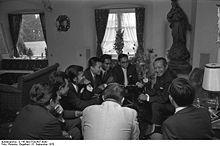 Suharto on a visit to West Germany in 1970.
Suharto on a visit to West Germany in 1970.
Within a few years, the Indonesian economy had been revived from its near collapsed state of the mid-1960s. It recorded strong annual economic growth for the three decades of Suharto's presidency, although much of these gains would be lost in the 1997/98 Asian financial crisis. Indonesia achieved self-sufficiency in rice production by the mid-1980s, a basic education to almost all citizens, and a successful family planning program.[7][35] Subsidies on basics such as food and fuel to maintain grass-roots support were costly to government budgets.
Although the Suharto regime claimed to have had success in reducing poverty, four in five Indonesians still lived below or only slightly above the level of $1 a day near the end of his rule. Suharto's former government ministers flatly stated the alleged lowering of poverty rates was false. The Suharto regime's definition of poverty was also inflated: it was a monetary sum, a rupiah base sufficient to enable the poor to get the internationally accepted norm of 2,100 calories a day. The cash amount had been less than the globally accepted poverty line of $1 a day. Until the 1998 crisis, it was only about half that in Indonesia's cities, and less in the countryside.[65]
Influence and business opportunity became increasingly concentrated within Suharto's family, relatives, favoured generals and a number of ethnic Chinese businessmen that he had known since his time in Semarang in particular Liem Siu Liong and Bob Hasan. Much of the funds flowed to foundations (yayasan) controlled by the Suharto family.[66] By the late '80s, the extent of the first family's business activities concerned even long-time military associates, such as General Benny Murdani. By the pre-financial crisis peak of the mid-1990s, the family's annual revenue was estimated in the billions of US dollars. Much of it was recycled back into pay-offs, patronage, military subsidies, and campaign funding.[7]
Foreign policy, Irian Jaya, East Timor and Aceh
Upon assuming power, Suharto dispatched his foreign minister Adam Malik to mend strained relations with the United States, the United Nations, and end the Sukarno-instigated Konfrontasi with Malaysia. Previously increasingly close relations with China were cut (diplomatic ties were restored in 1990). Suharto played an important role in the establishment of the Association of Southeast Asian Nations (ASEAN) in 1967 and the Asia-Pacific Economic Cooperation (APEC) in the early 1990s.[35] Officially, the "New Order" followed a foreign policy of neutrality.[7]
In 1969, Suharto's government reached an agreement with the United States and United Nations, to hold a referendum on self-determination for western New Guinea. The 1969 "Act of Free Choice" was open to 1022 "chiefs" and the unanimous decision for integration with Indonesia lead to doubts of its validity.[67] In 1975, Indonesia invaded East Timor and the following year declared East Timor the 27th province of Indonesia, a status never recognised by the United Nations. Following Suharto's 1998 resignation from the Presidency, the Indonesian government ceded control of East Timor in 1999 following a referendum vote for independence. An estimated minimum of 90,800 and maximum of 213,600 conflict-related deaths occurred in East Timor during the period 1974–1999 (i.e., 13% to 30.5% of the population); namely, 17,600-19,600 killings and 73,200 to 194,000 'excess' deaths from hunger and illness, although Indonesian forces were responsible for only about 70% of the violent killings.[68] According to Ben Kiernan; demographic evidence indicates a toll of about 170,000 deaths caused by all sides from 1975 to 1980, a sum that represents a quarter of the population (Kiernan concludes that it was proportionately comparable to the murder of--by his count--1.8 million people by the Communist Pol Pot regime in Cambodia from 1975 to 1979).[69] Noam Chomsky has referred to the 1975 Indonesian invasion and occupation of East Timor as the worst instance of genocide relative to population since the Holocaust.[70] In contrast, Indonesia scholar Robert Cribb has argued that the common estimate of 200,000 deaths by violence in East Timor is likely to be a significant exaggeration and that the most likely figure is closer to 80,000.[71]
In 1976, the Free Aceh Movement, or GAM, who demanded independence for Aceh from Indonesia. Suharto authorised troops to put down the rebellion, forcing several of its leaders into exile in Sweden.[72] Prolonged fighting between GAM and the Indonesian military and police led Suharto to declare martial law in the province, by naming Aceh a "military operational area" in 1990.[citation needed]
Politics and dissent
In 1970, corruption prompted student protests and an investigation by a government commission. Suharto responded by banning student protests, forcing the activists underground. Only token prosecution of the cases recommended by the commission was pursued. On 5 May 1980 a group of prominent military men, politicians, academics and students calling themselves the "Petition of Fifty" questioned Suharto's use of the national ideology Pancasila. The Indonesian media suppressed the news and the government placed restrictions on the signatories. After the group's 1984 accusation that Suharto was creating a one-party state, some of its leaders were jailed.[citation needed] In the same decade, it is believed by many scholars that the Indonesian military split between a nationalist "red and white faction" and an Islamist "green faction." As the 1980s closed, Suharto is said to have been forced to shift his alliances from the former to the latter, leading to the rise of Jusuf Habibie in the 1990s.
The New Order's economic achievements were a major foundation of support for Suharto support for decades. Economic growth, however, was causing great social change which was in contrast to the rigid political system built around the President. Social dislocation in rural areas and the formation of a new working class around large industrial areas led to a sense of social inequalities jealousies from the late 1980s. At the same time, the fast growing and prospering middle class grew increasingly uneasy with corruption and looked for greater political participation. Key figures and factions within the ruling elite began to jockey ready for Presidential succession as Suharto entered his late 60s.[73]
Following the end of the Cold War, Western concern over communism waned, and Suharto's human rights record came under greater international scrutiny. The 1991 killing of over 200 East Timorese civilians in Dili, East Timor, resulted in the Congress of the United States passing limitations on IMET assistance to the Indonesian military.[74] In 1993, under President Bill Clinton, the U.S. delegation to the UN Human Rights Commission helped pass a resolution expressing deep concern over Indonesian human rights violations in East Timor.[75]
By 1996, Megawati Sukarnoputri, the daughter of Sukarno, and chair of the Indonesian Democratic Party was increasingly critical of Suharto's "New Order". In response, Suharto backed a co-opted faction led by Deputy Speaker of Parliament Suryadi, which removed Megawati from the chair. A government crackdown on demonstrating Megawati supporters result in a number of deaths, rioting and the arrest of two-hundred. Those arrested were tried under the anti-Subversion and hate-spreading laws. It marked the beginning of a renewed crackdown by the New Order government against supporters of democracy, now called the "Reformasi" or Reformation.
Resignation
Main article: Fall of SuhartoThe Asian Financial Crisis had dire consequences for the Indonesian economy and society, and Suharto's regime. The Indonesian currency collapsed in value, foreign investment dried up, and mass layoffs of urban workers and price rises created tension across the country.[7][76] Suharto was re-elected for another five-year term in March 1998, stacking parliament and cabinet with his own family and business associates in the process. Increasingly, prominent political figures spoke out against Suharto's presidency, and university students organised nation-wide demonstrations.
The shooting of four student demonstrators in Jakarta in May 1998 triggered rioting across the city that destroyed thousands of buildings and killed over 1,000 people. Following public outrage at the events, a student occupation of the parliament building, street protests across the country, and the desertion of key political allies, on 21 May 1998 Suharto announced his resignation from the presidency. His recently appointed Vice President Habibie assumed the presidency in accordance with the constitution.[7][76][77]
Post-presidency
After his resignation, Suharto retired to a family compound in Central Jakarta, making few public appearances. Efforts to prosecute Suharto mostly centred around alleged mismanagement of funds, and their force has been blunted due to health concerns as well as lack of support within Indonesia for attempts to prosecute him. Suharto was never prosecuted.
Investigations of wealth
In May 1999, Time Asia estimated Suharto's family fortune at US$15 billion in cash, shares, corporate assets, real estate, jewelry and fine art. Of this, US$9 billion is reported to have been deposited in an Austrian bank. The family is said to control about 36,000 km² of real estate in Indonesia, including 100,000 m² of prime office space in Jakarta and nearly 40% of the land in East Timor. Suharto was placed highest on Transparency International's list of corrupt leaders with an alleged misappropriation of between US $15–35 billion during his 32-year presidency.[10]
On 29 May 2000, Suharto was placed under house arrest when Indonesian authorities began to investigate the corruption during his regime. In July 2000, it was announced that he was to be accused of embezzling US$571 million of government donations to one of a number of foundations under his control and then using the money to finance family investments. But in September court-appointed doctors announced that he could not stand trial because of his declining health. State prosecutors tried again in 2002 but then doctors cited an unspecified brain disease. On 26 March 2008, a civil court judge acquitted Suharto of corruption but ordered his charitable foundation, Supersemar, to pay US$110 m (£55 m).[78]
Related legal cases
In 2002, Suharto's son Hutomo Mandala Putra, more widely known as Tommy, was sentenced to 15 years jail. He had been convicted of ordering the killing of a judge who had sentenced him to 18 months jail for corruption and illegal weapons possession. In 2006, he was freed on "conditional release." following reductions in his sentence.[79]
In 2003, Suharto's half-brother Probosutedjo was tried and convicted for corruption and the loss of $10 million from the Indonesian state. He was sentenced to four years in jail. He later won a reduction of his sentence to two years, initiating a probe by the Indonesian Corruption Eradication Commission into the alleged scandal of the "judicial mafia" which uncovered offers of $600,000 to various judges. Probosutedjo confessed to the scheme in October 2005, leading to the arrest of his lawyers. His full four year term was reinstated. After a brief standoff at a hospital, in which he was reportedly protected by a group of police officers, he was arrested on 30 November 2005.
On 9 July 2007, Indonesian prosecutors filed a civil lawsuit against former President Suharto, to recover state funds ($440 m or £219 m, which allegedly disappeared from a scholarship fund, and a further $1.1 billion in damages).[80]
On 4 September 2007, mediation at the Attorney General's Office (AGO) between prosecutors and lawyers for Suharto over the Supersemar foundation civil lawsuit succeeded and thus the trial will have to commence.[81]
On 10 September 2007, Indonesia's Supreme Court awarded Suharto damages against Time Asia magazine, ordering it to pay him one trillion rupiah ($128.59 million). The High Court reversed the judgment of an appellate court and Central Jakarta district court (made in 2000 and 2001). Suharto had sued the U.S.-based Time magazine seeking more than $US 27 billion in damages for libel over a 1999 article which reported that he transferred stolen money abroad.[82]
Health crises
After resigning from the presidency, Suharto was hospitalised repeatedly for stroke, heart, and intestinal problems. His declining health negatively affected attempts to prosecute him on charges of corruption and human rights violations as his lawyers successfully claimed that his condition rendered him unfit for trial. Moreover, there was little support within Indonesia for any attempts to prosecute him. In 2006, Attorney General Abdurrahman announced that a team of twenty doctors would be asked to evaluate Suharto's health and fitness for trial. One physician, Brigadier General Dr Marjo Subiandono, stated his doubts about by noting that "[Suharto] has two permanent cerebral defects."[83] In a later Financial Times report, Attorney General Abdurrahman discussed the re-examination, and called it part of a "last opportunity" to prosecute Suharto criminally. Attorney General Abdurrahman left open the possibility of filing suit against the Suharto estate."[84]
Death
On 4 January 2008, Suharto was taken to the Pertamina hospital, Jakarta with complications arising from a weak heart, swelling of limbs and stomach, and partial renal failure.[85] His health fluctuated for several weeks but progressively worsened with anaemia and low blood pressure due to heart and kidney complications, internal bleeding, fluid on his lungs, and blood in his feces and urine which caused a haemoglobin drop.[86] On 23 January, Suharto's health worsened further, as a sepsis infection spread through his body.[87] His family consented to the removal of life support machines, and he died on 27 January at 1:10 p.m.[88][89]
Suharto's body was taken from Jakarta to the Giri Bangun mausoleum complex near the Central Java city of Solo. He was buried alongside his late wife in a state military funeral with full honours, with the Kopassus elite forces and KOSTRAD commandos as the honour guard and pallbearers and Commander of Group II Kopassus Surakarta Lt.Colonel Asep Subarkah.[90] In attendance were the incumbent president, Susilo Bambang Yudhoyono as "Ceremony Inspector", and vice-president, government ministers, and armed forces chiefs of staff. Tens of thousands of people lined the streets to see the convoy.[91] Condolences were offered by many regional heads of state, although certain regional leaders such as Helen Clark, the Prime Minister of New Zealand, boycotted the funeral,[92] whereas Indonesia's President Susilo Bambang Yudhoyono declared a week of official mourning.[93]
See also
- Purna Bhakti Pertiwi Museum (Suharto museum)
- History of Indonesia
- Timeline of Indonesian history
References
Notes
- ^ Berger, Marilyn (2008-01-28). "Suharto Dies at 86; Indonesian Dictator Brought Order and Bloodshed". New York Times. http://www.nytimes.com/2008/01/28/world/asia/28suharto.html. Retrieved 2008-01-30.
- ^ Schwarz (1994), p. 175
- ^ Soeharto, as related to G. Dwipayana and Ramadhan K.H. (1989), Soeharto: Pikiran, ucapan dan tindakan saya: otobiographi (Soeharto: His thoughts, words and deeds: an autobiography), PT Citra Lamtoro Gung Persada, Jakarta. ISBN 979-8085-01-9.
- ^ See the details in Chapter 2, 'Akar saya dari desa' (My village roots), in Soeharto, op. cit.
- ^ Friend (2003), pages 107–109; Chris Hilton (writer and director) (2001). Shadowplay (Television documentary). Vagabond Films and Hilton Cordell Productions.; Ricklefs (1991), pages 280–283, 284, 287–290
- ^ Miguel, Edward; Paul Gertler, David I. Levine (January 2005). "Does Social Capital Promote Industrialization? Evidence from a Rapid Industrializer". Econometrics Softare Laboratory, University of California, Berkeley.
- ^ a b c d e f g h i j k l m n o McDonald, Hamish (28 January 2008). "No End to Ambition". Sydney Morning Herald. http://www.smh.com.au/news/world/no-end-to-ambition/2008/01/27/1201368944638.html.
- ^ Commission for Reception, Truth and Reconciliation in East Timor Benetech Human Rights Data Analysis Group (February 9, 2006). "The Profile of Human Rights Violations in Timor-Leste, 1974–1999". A Report to the Commission on Reception, Truth and Reconciliation of Timor-Leste. Human Rights Data Analysis Group (HRDAG). http://www.hrdag.org/resources/timor_chapter_graphs/timor_chapter_page_02.shtml.
- ^ estimates of government funds misappropriated by the Suharto family range from US$1.5 billion and US$35 billion.(Ignatius, Adi (2007-09-11). "Mulls Indonesia Court Ruling". TIME. http://www.time.com/time/nation/article/0,8599,1660967,00.html?iid=sphere-inline-sidebar. Retrieved 2009-08-09.); Haskin, Colin, "Suharto dead at 86", Globe and Mail, January 27, 2008
- ^ a b "Suharto tops corruption rankings". BBC News. March 25, 2004. http://news.bbc.co.uk/2/hi/business/3567745.stm. Retrieved 2006-02-04.
- ^ Tempo (Jakarta), 11 November 1974.
- ^ a b McDonald (1980), p. 10.
- ^ a b McDonald (1980), p. 11.
- ^ a b c McDonald (1980), page 9
- ^ Haskin, Colin, "Suharto dead at 86", Globe and Mail, January 27, 2008
- ^ Romano, Angela Rose (2003). Politics and the press in Indonesia. p. ix. ISBN 0700717455.
- ^ Elson, Robert E. (2001). Suharto: A Political Biography. Cambridge, United Kingdom: Cambridge University Press. pp. 1–6. ISBN 0521773261.
- ^ McDonald (1980), pages 12–13
- ^ a b McDonald (1980), pages 13
- ^ Elson, Robert E. (2001). Suharto: A Political Biography. Cambridge, United Kingdom: Cambridge University Press. p. 8. ISBN 0521773261.
- ^ Oudang, R. (1954). Perkembangan kepolisian di Indonesia. Jakarta: Mahabarata. p. 36.
- ^ Elson, R.E. (2001). Suharto: A Political Biography. Cambridge, United Kingdom: Cambridge University Press. p. 9. ISBN 0521773261.
- ^ a b McDonald (1980), p. 14.
- ^ McDonald (1980), p. 16.
- ^ Elson, R.E. (2001). Suharto: A Political Biography. Cambridge, United Kingdom: Cambridge University Press. pp. 14–15. ISBN 0521773261.
- ^ Elson, R.E. (2001). Suharto: A Political Biography. Cambridge, United Kingdom: Cambridge University Press. pp. 15–17. ISBN 0521773261.
- ^ a b Elson, R.E. (2001). Suharto: A Political Biography. Cambridge, United Kingdom: Cambridge University Press. pp. 20–25, 28–29. ISBN 0521773261.
- ^ Reid 1974
- ^ Elson, R.E. (2001). Suharto: A Political Biography. Cambridge, United Kingdom: Cambridge University Press. pp. 29–38, 42–44. ISBN 0521773261.
- ^ McDonald, Hamish (1980). Suharto's Indonesia. Fontana Books. pp. 24–25. ISBN 0-00-635721-0.
- ^ McDonald, Hamish (1980). Suharto's Indonesia. Fontana Books. p. 25. ISBN 0-00-635721-0.
- ^ McDonald, Hamish (1980). Suharto's Indonesia. Fontana Books. pp. 30–31. ISBN 0-00-635721-0.
- ^ McDonald, Hamish (1980). Suharto's Indonesia. Fontana Books. pp. 31–32. ISBN 0-00-635721-0.
- ^ Schwarz (1994), pages 52–57
- ^ a b c Sheridan, Greg (28 January 2008). "Farewell to Jakarta's Man of Steel". The Australian. http://www.theaustralian.com.au/news/farewell-to-jakartas-man-of-steel/story-e6frg6v6-1111115412423. Retrieved 2010-04-14.
- ^ Ricklefs (1991), page 282
- ^ Ricklefs (1991), pages 272–80
- ^ Ricklefs (1991), page 281
- ^ Vickers (2005), page 156
- ^ Friend (2003), page 104
- ^ Ricklefs (1991), p. 282.
- ^ Ricklefs (1991), page 281–282
- ^ a b Friend (2003), page 105
- ^ a b Ricklefs (1991), pages 281–282
- ^ a b Vickers (2005), page 157
- ^ Ricklefs (1991), page 287
- ^ Vickers (2005), pages 158–159
- ^ Ricklefs (1991), p. 288
- ^ Friend (2003), p. 113
- ^ Vickers (2005), p. 159
- ^ Robert Cribb (2002). "Unresolved Problems in the Indonesian Killings of 1965–1966". Asian Survey 42 (4): 550–563. doi:10.1525/as.2002.42.4.550. JSTOR 3038872.
- ^ Vickers (2005), pages 159–60
- ^ Ricklefs (1991), p. 287.
- ^ Schwartz (1994), pages 2 & 22
- ^ a b Vickers (2005), page 160
- ^ "Sukarno Removes His Defence Chief". New York Times. 22 February 1965.
- ^ McDonald (1980), p. 60.
- ^ a b Schwartz (1994), page 2
- ^ Ricklefs (1991), p. 295.
- ^ Aspinal (1999), p.ii
- ^ Schwartz (1994), p. 3.; Aspinall (1999), pp. i & ii.
- ^ Schwartz (1994), page 106
- ^ snb.or.id; Inside Indonesia
- ^ "Indonesia Economic". Commanding Heights. PBS/WBGH. http://www.pbs.org/wgbh/commandingheights/lo/countries/id/id_economic.html. Retrieved 23 May 2005.
- ^ Speak No Evil: Why the World Bank Failed to Anticipate Indonesia's Deep Crisis by Marcus W. Brauchli. Wall Street Journal. (Eastern edition). New York, N.Y.: July 14, 1998. pg. A.1
- ^ Koerner, Brendan (March 26, 2004). "How Did Suharto Steal $35 Billion? Cronyism 101". Slate. http://www.slate.com/id/2097858. Retrieved 2006-02-04.
- ^ Simpson, Brad (July 9, 2004). "Indonesia's 1969 Takeover of West Papua Not by "Free Choice"". National Security Archive. http://www.gwu.edu/~nsarchiv/NSAEBB/NSAEBB128/index.htm.
- ^ Benetech Human Rights Data Analysis Group (February 9, 2006). "The Profile of Human Rights Violations in Timor-Leste, 1974–1999". A Report to the Commission on Reception, Truth and Reconciliation of Timor-Leste. Human Rights Data Analysis Group (HRDAG). http://www.hrdag.org/resources/timor_chapter_graphs/timor_chapter_page_02.shtml.
- ^ http://www.yale.edu/gsp/publications/KiernanRevised1.pdf[dead link]
- ^ "Indonesia at the Crossroads: U.S. Weapons Sales and Military Training". Worldpolicy.org. http://www.worldpolicy.org/projects/arms/reports/indo101001.htm#etimor. Retrieved 2009-08-09.
- ^ http://works.bepress.com/cgi/viewcontent.cgi?article=1001&context=robert_cribb[dead link]
- ^ Miller, Michelle Ann. (2008). Rebellion and Reform in Indonesia. Jakarta's Security and Autonomy Policies in Aceh, London, Routledge, pp.5–6. ISBN 978-0-415-45467-4
- ^ Aspinal (1999), pp. ii-iii
- ^ "H.AMDT.647 (A003): An amendment to prohibit any funds appropriated in the bill to be used for military education and training assistance to Indonesia". THOMAS (Library of Congress). http://thomas.loc.gov/cgi-bin/bdquery/z?d102:HZ00647:. Retrieved 2006-02-04.
- ^ "United Nations High Commission on Human Rights resolution 1993/97: Situation in East Timor". United Nations. http://www.unhchr.ch/Huridocda/Huridoca.nsf/0/81427c9bacaf9847c1256c6800603ff2?Opendocument. Retrieved 2006-02-04.
- ^ a b Vickers (2005), pp. 203–207.
- ^ E. Aspinall, H. Feith, and G. Van Klinken (eds) The Last Days of President Suharto, Monash Asia Institute, pp.iv-vii.
- ^ "Suharto charity told to pay $110 m". 2008-03-27. http://news.bbc.co.uk/2/hi/asia-pacific/7315976.stm. Retrieved 2010-01-06.
- ^ "Asia-Pacific | Tommy Suharto freed from prison". BBC News. 2006-10-30. http://news.bbc.co.uk/2/hi/asia-pacific/6098010.stm. Retrieved 2009-08-09.
- ^ "Civil suit filed against Suharto". BBC News. July 9, 2007. http://news.bbc.co.uk/2/hi/asia-pacific/6283322.stm.
- ^ "Jakartapost.com, Mediation fails, Soeharto civil trial continues". http://www.thejakartapost.com/detailheadlines.asp?fileid=20070905.A07&irec=6.
- ^ From correspondents in Jakarta (2007-09-10). "News.com.au, Suharto wins $128 m in damages". News.com.au. Archived from the original on October 17, 2007. http://web.archive.org/web/20071017221608/http://news.com.au/heraldsun/story/0,21985,22396808-5005961,00.html. Retrieved 2009-08-09.
- ^ "Former Indonesian dictator unfit to stand trial — doctor". The Sydney Morning Herald. Associated Press. April 23, 2006. http://www.smh.com.au/news/world/former-indonesian-dictator-unfit-to-stand-trial--doctor/2006/04/22/1145344319571.html.
- ^ Donnan, Shawn (April 28, 2006). "Jakarta makes final attempt to pursue Suharto charges". Financial Times. http://news.ft.com/cms/s/9bd74ff6-d652-11da-8b3a-0000779e2340.html.
- ^ "Indonesia's ailing Suharto 'getting worse': doctors". Arabtimesonline.com. 2008-01-05. http://www.arabtimesonline.com/client/pagesdetails.asp?nid=10341&ccid=18. Retrieved 2009-08-09.
- ^ "Suharto condition 'deteriorating'". BBC News. 2008-01-08. http://news.bbc.co.uk/2/hi/asia-pacific/7176176.stm. Retrieved 2009-08-09.
- ^ Jakarta Post, Suharto's health deteriorates, infection spreads, January 24 2008; OkeZone.com
- ^ "Indonesia ex-leader Suharto dies". BBC News. 2008-01-27. http://news.bbc.co.uk/2/hi/asia-pacific/7211565.stm. Retrieved 2009-08-09.
- ^ "Asia-Pacific — Suharto has multiple organ failure". Al Jazeera English. 2008-01-14. http://english.aljazeera.net/news/asia-pacific/2008/01/2008525125442432751.html. Retrieved 2010-04-14.
- ^ "— Presiden Tiba di Astana Giribangun". Tempointeraktif.com. http://www.tempointeraktif.com/hg/nasional/2008/01/28/brk,20080128-116371,id.html. Retrieved 2009-08-09.
- ^ Tedjasukmana, Jason (2008-01-29). "Indonesia Bids Farewell to Suharto". TIME. http://www.time.com/time/world/article/0,8599,1707754,00.html. Retrieved 2009-08-09.
- ^ "NZ won't sign Suharto condolence book, January 29, 2008". News.com.au. 2008-01-29. http://www.news.com.au/heraldsun/story/0,21985,23127319-5005961,00.html. Retrieved 2009-08-09.[dead link]
- ^ "Geoff Thompson, Suharto's body arrives home, ABC News January 27, 2008". Abc.net.au. 2008-01-27. http://www.abc.net.au/news/stories/2008/01/27/2147555.htm. Retrieved 2009-08-09.
General
- "Two former strongmen, Soeharto-Lee Kuan Yew meet again". ANTARA. February 22, 2006. http://www.antara.co.id/en/seenws/?id=9296. Retrieved 2006-02-22.[dead link]
- "Army in Jakarta Imposes a Ban on Communists". New York Times. 19 October 1965.
- Aspinall, Ed (October–December 1996). "What happened before the riots?". Inside Indonesia. http://www.insideindonesia.org/edit48/ed.htm.
- "Attorney general doubts Soeharto can be prosecuted". Jakarta Post. May 27, 2005.
- Blum, William (1995). Killing Hope: US Military and CIA Interventions Since World War II. Monroe, Me.: Common Courage Press. ISBN 1-56751-052-3.
- Camdessus Commends Indonesian Actions. Press Release. International Monetary Fund. (October 31, 1997)
- "CIA Stalling State Department Histories". The National Security Archive. http://www.gwu.edu/~nsarchiv/NSAEBB/NSAEBB52/. Retrieved May 23, 2005.
- Colmey, John (May 24, 1999). "The Family Firm". TIME Asia. http://www.time.com/time/asia/asia/magazine/1999/990524/cover1.html.
- Elson, Robert E. (2001). Suharto: A Political Biography. Cambridge, United Kingdom: Cambridge University Press. ISBN 0-521-77326-1.
- Friend, Theodore (2003). Indonesian Destinies. The Belknap Press of Harvard University Press. ISBN 0-674-01834-6.
- "H.AMDT.647 (A003): An amendment to prohibit any funds appropriated in the bill to be used for military education and training assistance to Indonesia". THOMAS (Library of Congress). http://thomas.loc.gov/cgi-bin/bdquery/z?d102:HZ00647:. Retrieved 2006-02-04.
- "Indonesia: Arrests, torture and intimidation: The Government's response to its critics". Amnesty International. November 27, 1996. http://web.amnesty.org/library/eng-idn/index&start=391.[dead link]
- "Indonesia Economic". Commanding Heights. http://www.pbs.org/wgbh/commandingheights/lo/countries/id/id_economic.html. Retrieved May 23, 2005.
- "Jakarta Cabinet Faces Challenge". New York Times. December 16, 1965.
- "Jakarta Leftist Out As Army Chief" New York Times October 15, 1965
- Koerner, Brendan (March 26, 2004). "How Did Suharto Steal $35 Billion? Cronyism 101". Slate. http://www.slate.com/id/2097858. Retrieved 2006-02-04.
- "Jakarta Cabinet Faces Challenge". New York Times. December 16, 1965.
- Lashmar, Paul and Oliver, James (April 16, 2000). "MI6 Spread Lies to Put Killer In Power". The Independent.
- Lashmar, Paul; Oliver, James (1999). Britain's Secret Propaganda War. Sutton Pub Ltd. ISBN 0-7509-1668-0.
- "Public Expenditures, Prices and the Poor". World Bank. 1993. http://wbln0018.worldbank.org/dg/povertys.nsf/0/2f56edbf2ef22ff185256b2100754284?OpenDocument.
- Ricklefs, M.C. 1991. A History of Modern Indonesia since c.1300. 2nd Edition, Stanford: Stanford University Press. ISBN 0-333-57690-X
- Simpson, Brad (July 9, 2004). "Indonesia's 1969 Takeover of West Papua Not by "Free Choice"". National Security Archive. http://www.gwu.edu/~nsarchiv/NSAEBB/NSAEBB128/index.htm.
- Schwarz, A. (1994). A Nation in Waiting: Indonesia in the 1990s. Westview Press. ISBN 1-86373-635-2.
- "Suharto tops corruption rankings". BBC News. March 25, 2004. http://news.bbc.co.uk/2/hi/business/3567745.stm. Retrieved 2006-02-04.
- "Sukarno Removes His Defense Chief" New York Times February 22, 1966
- "Tapol Troubles: When Will They End?". Inside Indonesia. April–June 1999. http://insideindonesia.org/index.php/component/content/693?task=view.
- Toer, Pramoedya Ananta (2000). The Mute's Soliloquy: A Memoir. Penguin. ISBN 0-14-028904-6.
- "United Nations High Commission on Human Rights resolution 1993/97: Situation in East Timor". United Nations. http://www.unhchr.ch/Huridocda/Huridoca.nsf/0/81427c9bacaf9847c1256c6800603ff2?Opendocument. Retrieved 2006-02-04.
Further reading
- McDonald, H., Suharto's Indonesia, Fontana Books, 1980, Blackburn, Australia, ISBN 0006357210
- McGlynn, John H. et al., Indonesia in the Soeharto years. Issue, incidents and images, Jakarta 2007, KITLV
- Schwarz, A. 1999, A Nation in Waiting: Indonesia's Search for Stability, Westview Press; 2nd edition (October 1999), ISBN 0-8133-3650-3
- "Vengeance with a Smile", Time Magazine, Friday, Jul. 15, 1966
- Retnowati Abdulgani-Knapp; Soeharto: The Life and Legacy of Indonesia's Second President: An Authorised Biography'. Marshall Cavendish Editions; ISBN 9812613404, ISBN 978-9812613400
External links
- news.bbc.co.uk, Life in pictures: Indonesia's Suharto BBC
- Financial Times obituary
- The Guardian obituary
- Obituary in The Times, January 28, 2008
- "Suharto, Inc." May 1999 Time Magazine exposé on Suharto's regime and family, published on the first anniversary of Suharto's resignation
- Shadow Play — Website accompanying a 2002 PBS documentary on Indonesia, with emphasis on the Suharto-era and the transition from New Order to Reformation
- "Suharto to Iraq: Nothing has changed" – Article by British journalist and Suharto critic John Pilger on the fortieth anniversary of the Transition to the New Order in Zmag (originally published in the New Statesman).
- Tiger Tales: Indonesia — Website accompanying a 2002 BBC World Service radio documentary on Indonesia, focusing on early Suharto era. Features interviews with Indonesian generals and victims of the regime. Program is available in streaming RealAudio format.
Military offices Preceded by
Pranoto ReksosamudraIndonesian Army Chief of Staff
1965–1967Succeeded by
Maraden PanggabeanVacant Position abolished by Sukarno after October 17, 1952 incidentTitle last held byT B Simatupang
As Chief of Staff of the Battle ForcesCommander-in-Chief of the Indonesian Armed Forces
1969–1973Succeeded by
Maraden PanggabeanPolitical offices Preceded by
SukarnoPresident of Indonesia
12 March 1967 – 21 May 1998Succeeded by
Bacharuddin Jusuf HabibieDiplomatic posts Preceded by
Dobrica ĆosićSecretary General of Non-Aligned Movement
1992–1995Succeeded by
Ernesto Samper PizanoPresidents of Indonesia 
Sukarno · Suharto · Bacharuddin Jusuf Habibie · Abdurrahman Wahid · Megawati Sukarnoputri · Susilo Bambang Yudhoyono

Secretaries-General of the Non-Aligned Movement [[be-x-old:Мухамад Сухарт
Categories:- 1921 births
- 2008 deaths
- Presidents of Indonesia
- Cold War leaders
- Cardiovascular disease deaths in Indonesia
- Deaths from lung disease
- Deaths from renal failure
- Indonesian generals
- Indonesian Sunni Muslims
- Javanese people
- Leaders who took power by coup
- New Order (Indonesia)
- People from Yogyakarta
- Suharto
- Honorary Knights Grand Cross of the Order of the Bath
- Golkar politicians
Wikimedia Foundation. 2010.

